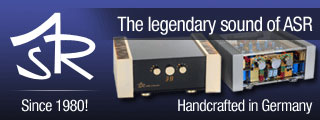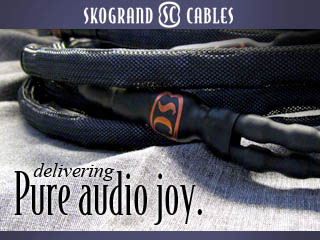Steve Nugent’s goal to make listening to digital sources more consistent with the use of a computer source. He shares, “It’s not so much that a computer is optimum for digital playback. It’s more that the classical optical disk transport (CD player) is not optimum. Either can be stellar if they are designed right, but the closer that a CD transport becomes like a computer with a CDROM disk drive, the better the result.” The advantage Steve speaks of is that of “… free-running master clocks which feed the data from static memory, allowing the jitter from the data stream to be minimized.” Steve’s perspective is that elimination of master clock jitter, which usually originates in the digital source or interface, is the most important part of optimizing a digital playback system.
Steve seems to rate the clocking, specifically the elimination of timing errors from the source, as more important than the conversion by the DAC: “The DAC is certainly important, but I have encountered no DACs that reject all incoming jitter. They don’t exist IME. Therefore, it’s important that the digital source, whether it’s a network interface like Sonos, Apple TV or Squeezebox, a CD transport, or a USB interface deliver the lowest possible jitter in the data stream.”
This sounds terrifically good in theory, and it may lead one to believe that the perfecting of the “jitter-free data stream” is what digital playback is all about. It may also lead some to conclude that the selection of DAC is of less consequence as the jitter in the source is eliminated. Are those statements true; that is, are they true in the user’s experience? This article will explore such questions
The Synchro-Mesh effect: shaping/smoothing
The predominant influence of the Synchro-Mesh upon listening is to give the impression that the music has been “smoothed” or contoured such that the digital rough edges have been eliminated, an “anti-digititis” effect. Less capable players, servers and streaming audio have a roughness to them, a bit too much bite with the definition. This may seem strange or even silly to those who have had little experience with multiple digital sources. But those who have heard the progression of players or the advancements in refinement of file playback through the years will nod their head in agreement.
To a degree, the Synchro-Mesh returns lushness and suppleness to the system. In use with three digital sources, two players and one streaming audio or file playback, I found the influence of the Synchro-Mesh to be consistent. It smoothed the signal no matter the digital source which was placed before it. That smoothing character took the form of warming and rounding the sound, such that one might think that a tube component had been inserted into the rig. Vinylphiles would identify the effect as having moved closer to analogue sound as opposed to digital sound.
One system I developed for comparison was:
Simaudio Moon Evolution 750D DAC/Player; Clarity Cable Organic (coaxial) Digital 1m; Eastern Electric Minimax DAC Plus with upgraded DEXA NewClassD Opamps; Clarity Cable Organic RCA Interconnects; Purity Audio Design Silver Statement Preamplifier; Clarity Cable Organic Balanced IC; Jones Audio M300 Monoblock Amplifiers (under review); Clarity Organic Speaker Cables bi-wired; Kingsound King III ESL Speakers (under review).
Consequently, I have a rarified rig to hear the nuances which the Synchro-Mesh yields. I had recently scavenged a precious gem, a copy of the Spinners’ greatest hits entitled Flashback with the Spinners. One of my all-time feel good songs, “Rubberband Man” contains backing horns with a soul twist, a sound not too far removed from Chicago, a group I listened to a great deal as a teen. Also, I am a sucker for synth effects, and there’s a great one – a lower frequency “twang” of a giant virtual rubber band – keeping tempo in the song.
The initial impact of the Synchro-Mesh was that it veiled the drumstick thwacks and twang of the synth appreciably. Using the EE DAC alone, such particulars of the song stood out in contrast, but with the Synchro-Mesh they were blended more, and were thus less distinct. Similar effect was noticed when playing David Benoit’s “Every Step of the Way,” which features piano and distinct cymbal and chime work. The piano was larger and richer sounding without the Synchro-Mesh and the cymbals more delicate. These results did not mesh with what Steve had indicated.
Lest you think that these results were due to the megabuck transport, I assure you they were not. I obtained similar results (note, not similar sound!) with a NAD C521 CD Player acting as a transport to the EE DAC. In addition, like any other digital device the Synchro-Mesh is influenced by cabling, so try two or three brands of digital cables to see which flavor strikes your fancy.
Does power affect timing?
I suspected that improvement could be had with a better power supply. I have found that the power supply for digital equipment is as crucial as for any component. A power supply on a CD player can transform digital playback from mundane to exhilarating, as is the case with the Simaudio 750D. The Simaudio has the most robust power supply of any player I have used, and digital playback was superlative as a result. I had mentioned the benefit of an enhanced, balanced power supply to Steve, who was not convinced enough of its efficacy to supply one. He was agreeable to my discussing with Kevin Hayes of VAC in securing a PS similar to the Royal Power Supply developed for the Kingsound King ESL. Those Royal PS had made a sizable improvement to the speaker’s performance.
It would have been convenient to test this approach by using one of the Royal Power Supplies from the King speakers, however, this would have necessitated using a different set of speakers. There was an impediment, a slight variation in the size of the barrel of the 12V plugs – just enough to make the ones for the Syncro-Mesh and the Royal Power Supply incompatible. I discussed the situation with Kevin, who was willing to put a regulated power supply together. However, he is a tremendously busy man for a good reason. He builds extreme amplification components and was running such a backlog that a reviewer’s experiment with 12V plugs was not at the top of his “To Do” list. As he apologized at being indisposed, I proceeded to my next best option, an outboard power conditioner. Simply plugging the Synchro-Mesh into my antique Tice Audio Powerblock upgraded its performance markedly. Now, it was more on a level playing field with the EE Dac Plus. The two were not identical, but they were closer. No longer was the influence of the Synchro-Mesh predominantly subtractive, but rather neutral in its effect. Whereas prior it had sucked away wanted detail and gave not so much in return, now what little detail was lost was compensated for by more rounding, more smoothing such that it would be subjective to declare either setup a clear winner.
Just how does power conditioning elevate the performance of a reclocker? I do not know, but I was not surprised that it did. With the power conditioning added, the Synchro-Mesh’s influence was similar to that of networked cabling. Macro-dynamics stood out and the focus narrowed slightly to highlight the center image. Now the rubber band synth effect subtly peeked out between the notes of the right channel, and though the piano of David Benoit didn’t reverberate quite as long in the background, it did have a pleasing fullness.
- ← Previous page
- (Page 2 of 3)
- Next page →




I’ve always been curious about the product, but you didn’t, or at least explicitly, mention if you’re using upsampling with the Synchro-Mesh. I assume your sources are redbook and have the 96KHz version of SM (there’s a 44K version I think)? I remember reading in forums where Steve Nugent stated that SM’s upsampling is quite good but not ideal. So, it’s possible that the degradation of sound you heard is due to upsampling and not due to whether it’s more or less jitter. If the degradation of sound is due to anything jitter related, that’s a negative review for BOTH ESS Sabre and SynchroMesh, since this shows the ESS Sabre chip is sensitive to jitter nevertheless.
From my limited computer audio experience, I have not heard any software upsampling algorithm (SOX, PPHS, Secret Rabit and others) that does not degrade the sound slightly, so I’d venture to guess that most of your sonic impression is about the upsampler.
Ming,
God’s Joy to you,
Yes, I used the 96kHz version of the SM. I believe, if I am not mistaken, that the NAD player is an oversampling, but not upsampling player. If so, then I did indeed use a non-upsampling player and achieved similar results as upsampling player and dac. (I attempted to find the manual or specifications of the NAD player online and was not successful; I am open to correction if I am wrong about the player being non-upsampling.) If so, then it would seem the question remains one of how the products handle jitter.
Blessings,
Douglas Schroeder